
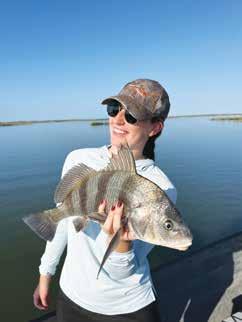



Black drum plentiful, consistent along Coastal Bend
By Nate Skinner For Lone Star outdoor newS
Anglers have been taking advantage of consistent schooling action from black drum across flats along the waters of the Coastal Bend.
Some drum are schooling over deeper grass beds in 3-4 feet of water, while others have been found along shallower flats littered with both seagrass and sand pockets. Fresh dead shrimp has been the bait of choice for those sightcasting to the schools of fish.
Capt. Ryan Sinclair has been pursuing black drum with his anglers along the upper Laguna Madre out North Padre Island, where he said the fish have been congregating in large schools

By Nate Skinner
For Lone Star outdoor newS
With daytime temperatures soaring, wild hogs are spending most of their time on their feet at night. Many hunters are
pursuing the pigs after dark with thermal optics in fields where they are feeding.
Some hunters have been lucky enough to come across large groups of hogs, while others have had more sporadic action. Recent rains and thriving vegetation
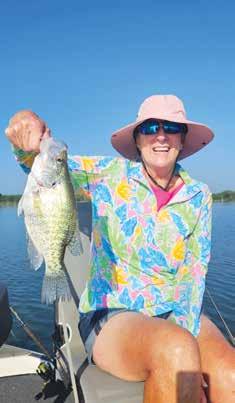
across many properties have kept pigs spread out in certain areas.
Houston-area sales rep for Fusion Thermal, Ryan Warner, chased pigs on a property he and his dad lease in Throckmorton County with some buddies. He was
from mid-morning to the midday hours.
“There are several big schools roaming over grass beds in about 3 feet of water,” Sinclair said. “We are sightcasting to them with a chunk of fresh dead shrimp. The key has been waiting until you see the school of fish to cast. If you try blind casting, you’re most likely going to have your bait stolen by perch.”
The schools of drum have been
Please turn to page 11

H.R.1, also called the “One Big Beautiful Bill,” included a significant change for hunters and gun owners who use or plan to use suppressors.
The bill includes a reduction of the tax
Please turn to page 22
By Nate Skinner For Lone Star outdoor newS
The crappie bite has been excellent at times for some anglers, while others would describe the action as hit-or-miss.
Brush piles have been holding large numbers of fish, but many of these crappie are on the small side. Larger fish have been concentrating along timber near the edges of river and
creek channels. Covering water has been the key to consistently finding larger crappie, and both minnows and jigs are producing.
On Lake Ray Roberts, guide Daniel Koberna said finding consistent numbers of large crappie has been either good or bad. He’s been focusing on timber along the edges of creek channels in 12-18 feet of water.
“There are a ton of fish over
brush piles in 25 feet of water, but a lot of those fish are small,” Koberna said. “You can catch some nice crappie over deep brush piles, you’re just going to have to weed through a ton of undersized fish.”
Rather than dealing with the swarms of smaller crappie, Koberna has been covering plenty of water to target larger fish.
“We are catching quite a few crappie in the 12- to 15-inch



WHATEVER YOUR ADVENTURE IS, WE'VE GOT YOU COVERED.




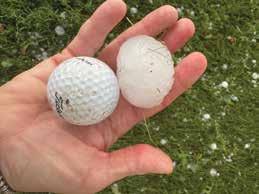
Dr. Dan Foley has been studying the impact of hailstorms on quail populations across the Rolling Plains, and concluded the balls of ice can bring localized devastation to quail, particularly during their most vulnerable reproductive and brooding periods.
When storms strike during the day, quail may be foraging in open areas, sometimes without adequate overhead cover, Foley wrote. Even though they may attempt to flee or hunker down in protective vegetation, their exposure can still result in lethal injuries from hailstones — especially those over an inch in diameter. Chicks with their reduced mobility rely on adults for warmth and shelter and are especially at risk of being killed outright or dying from exposure in the aftermath of a hailstorm.
The risks increase when hailstorms strike at night, Foley concluded, as quail roost on the ground in grasses and weeds without much overhead woody cover. This strategy allows them to flush easily if disturbed while roosting but also leaves them vulnerable to being pummeled by hailstones.
Hens that remain on the nest are particularly susceptible, often found dead after shielding their eggs. Their fidelity to the nest and inability to seek cover at night may result in high mortality rates during nocturnal hail events.
The Rolling Plains Quail Research Ranch experienced such an event on April 4. Hailstones the size of Ping Pong balls were recorded. At the time, 72 quail were being monitored with VHF radio collars. The following morning, eight collared quail were found dead, presumably from hail, as no signs of predation were present.
“Accordingly, this single event killed 11 percent of our radio-collared birds,” Foley said.
Were the losses ranch-wide? The ranch’s population was estimated at 1,788 birds, and approximately 196 may have been lost in the storm.
Hailstorms also can cause substantial destruction to nests by crushing or damaging eggs, or rendering them nonviable due to exposure and chilling.
What can land managers do?
Foley said certain strategies can mitigate the impacts of hail.
“Maintaining a diverse range of vegetation structures across the landscape increases the chances that quail will find effective cover during sudden weather events,” he said. “Pricklypear cactus may provide functional storm shelters. Promoting habitat mosaics with varying grazing intensities and preserving pockets of desirable shrubs and pricklypear may offer refuge during storms and allow for quicker recovery afterward.”

By Conor Harrison Lone Star outdoor newS
Catastrophic floods hit Central Texas along the Guadalupe River over the July 4th weekend, bringing devastation to many along the river.
The Kerrville-based Exotic Wildlife Association is offering a helping hand to anyone, member or not, impacted by the devastating floods
According to EWA Executive Director Ken Yancy, the organization put out multiple notices to anyone seeking assistance or those members who could help recovery efforts.
“We believe there likely were some impacted ranches,” Yancy said. “We sent an e-blast Monday morning that if somebody was impacted, please let us know and we’d do our best to match resources. A bunch of people have reached out to
help, but it is still very early in the process.”
Yancy said his group would assist in rebuilding any fences or providing supplemental feed or care to animals as the need arose.
Other area outfitters, along with game wardens, were pitching in to help recovery efforts with helicopters to search and volunteers walking the flood-ravaged areas.
By Craig Nyhus Lone Star outdoor newS
At the Texas Bighorn Society 2025 Roundup at Tapatio Springs, in Boerne, Clay Brewer was named the organization’s president.
Brewer was the former program leader for Texas Parks and Wildlife Department’s mule deer, pronghorn and bighorn sheep, a regional director and interim Wildlife Division director, a former chair of the Wild Sheep Working Group for the Western Association of Fish and Wildlife Agencies, and the Conservation Director and Bighorn Sheep lead at the Wild Sheep Foundation.
“We had a really good Roundup,” he said. “People came from all over, and they are passionate about wild sheep.”
Brewer said revenue generated was better than expected, especially since TBS wasn’t
selling a desert bighorn ram tag this year.
“Usually that hurts our revenue, but thanks to landowner donations we made up for it,” he said.
Brewer has lofty goals for the desert bighorn and for the organization, despite a reduction in desert bighorn sheep numbers from an estimated 1,500 to less than 500.
“I’ve been involved in the Texas sheep program for 30 years,” he said. “I was there when it was restored to historic levels, only to watch the bottom fall out.”
Brewer said his goal is to get groups together, working toward solutions.
“We’re going to have to think long term and bigger partnerships,” he said. “It’s not like it was when you had water development and the sheep would thrive. We need to work with multiple partners.”
Landowner participation is
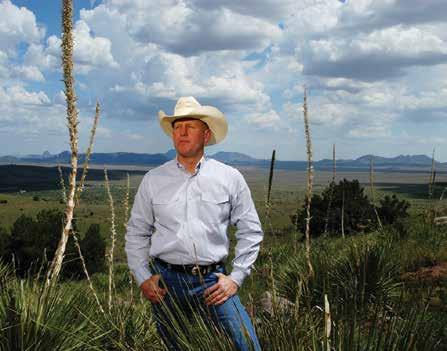
ble.”
crucial, Brewer said.
“Landowners have to make a living some way,” he said.
“We don’t want to tell a landowner what they can or can’t do. We need them at the ta-
By Miguel Morales
For Lone Star outdoor newS
At age 29, Brannen Vader manages the 3,250-acre El Papalote Ranch in Maverick County.
Vader, originally from New Braunfels, spent all of his free time at the family hunt ing lease along the Guadalupe River.
“From a very young age it just became part of who I am — we didn’t just grow up tro phy hunting but also to fill the freezer,” he said. “We did focus on harvesting the more mature deer, and with that came learning about proper overall management.”
In the summer when Vader was out of middle school, he would spend time at his aunt and uncle’s ranch in Frio County do ing manual labor, field dressing and learn ing how to guide.
Around 2008, his uncle trusted him to guide his first clients by himself, and he fell in love with it.
“I just knew this was something I wanted to do,” Vader said. “If I could make a job out of doing something I love like this, I wouldn’t want to do anything else.”
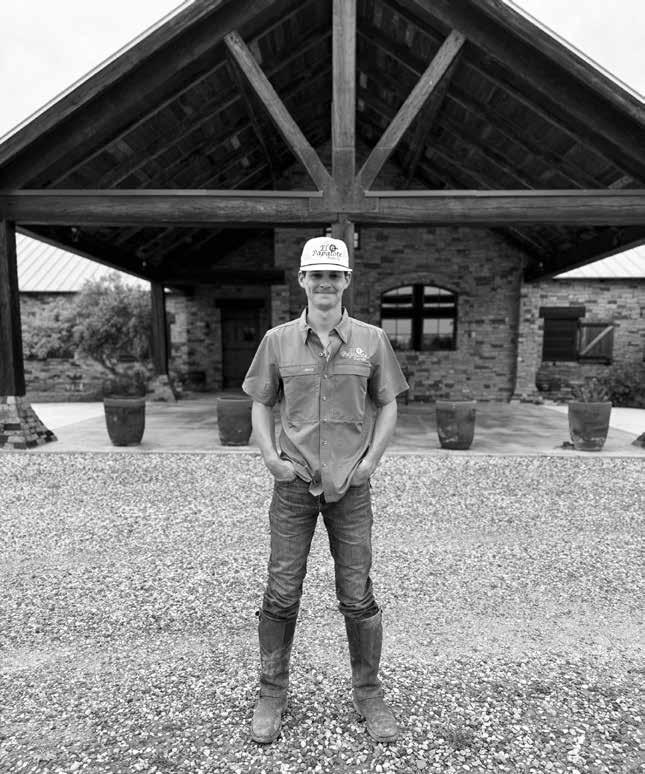
Vader went on to attain a degree from Texas A&M University-Kingsville in range and wildlife management. After graduating, he went on to manage the Lost Creek Ranch in North Texas with his wife, Cheyenne, then ultimately made his move to the El Papalote Ranch toward the end of the 2024 hunting season.
The El Papalote is located about halfway between La Pryor and Eagle Pass. The semicommercial hunting ranch has white-tailed deer, and 26 species of exotics have been added over the last 3 1/2 years. There is currently no cross fencing, the only other fencing inside the ranch besides the perimeter fencing is three soft release pens for new exotics.
The ranch offers a limited number of whitetail hunts per year in order to preserve the population and ensure the growth of trophy deer year after year. Each whitetail hunt package comes with one trophy and, if time remains, one management buck and doe.






Although testing is still in the early stages and the sample size remains small, initial results from a study this past hunting season on the effectiveness of QuailGuard in bobwhite quail is providing some positive results and hope for the future.
Thanks to a collaborative pilot study between the Rolling Plains Quail Research Foundation and Park Cities Quail Coalition, parasite assessments were conducted on hunter-harvested quail from across the Rolling Plains Ecoregion, focusing on two common and impactful parasites: eyeworms and cecal worms.


Samples were submitted from 24 ranches, totaling nearly 400 birds examined for parasitic infection. Among these ranches, eight had implemented the use of QuailGuard — a medicated feed designed to reduce internal parasite loads — starting in late fall 2024. Although these ranches had only undergone a single treatment cycle, the preliminary results offer encouraging insights.
According to RPQRF, across the entire ecoregion, the average prevalence of eyeworms in bobwhite quail was recorded at 80.2 percent. Adult birds exhibited an average intensity of 15 eyeworms per bird, while juveniles averaged six. Cecal worms showed an even higher prevalence: 93.5 percent of quail were infected, with adults harboring an average of 182 worms and juveniles 125.
However, when partitioned by treatment, a downward trend in parasite loads emerged among birds from QuailGuard-fed ranches. Eyeworm intensity declined from
9.15 worms per bird on non-medicated properties to 6.84 on medicated ones.
Similarly, cecal worm intensity dropped from 153.48 to 119.95 worms per bird. Though not statistically significant due to sample size, these findings suggest a biological effect worth deeper exploration.
One informative case came from a single ranch where both medicated and non-medicated feed areas existed side-byside. Quail harvested from the medicated area showed dramatically lower parasite burdens — averaging four eyeworms and 186.17 cecal worms per bird — compared to 15.64 and 305.45, respectively, in the nonmedicated pastures.
While the pilot data from fall 2024 showed promising early effects of medicated feed, the Snipes Ranch in Stonewall County offers a compelling long-term perspective. After seven consecutive years of administering QuailGuard, the intensity of parasite infection on this property has dropped markedly. Eyeworm counts averaged just 2.94 per bird, and cecal worm counts averaged 51.51 — both significantly lower than the regional averages of 15 and 182, respectively. These results suggest that long-term implementation of medicated feeding can yield sustained reductions in parasite load.
More robust data is needed to draw definitive conclusions, but this effort suggests that even a single season of medicated feeding can result in a measurable reduction in parasite load.
Recognizing the importance of these initial findings, RPQRF has launched a longterm study to further evaluate QuailGuard efficacy. This expanded research effort will incorporate larger sample sizes, controlled replication, and multi-year monitoring, with an anticipated conclusion in 2028.
Continued from page 4


impacted, even from aoudad population reduction.
“I think solutions are out there,” he said. “We need all conservation organizations, agencies and landowners at the table to formulate plans, so my goal is to get all the right people to the table and work to continue to restore sheep.”
Brewer said the task will be challenging.
“There is limited bighorn sheep habitat in Texas,” he said. “We can’t afford to lose what we have.”
Brewer said the recent bill allowing aoudad hunting from helicopters will help.
“Aoudad are impacting mule deer and livestock operations, not just sheep,” he said. “It’s part of the solution.”
Brewer’s main goal? To restore bighorn to their rightful place on the landscape.
“It (the bighorn restoration) has been described as the greatest wildlife success story in history,” he said. “Now we are watching it decline, and many people don’t even know about it. If I didn’t think there was hope, I wouldn’t stick around. I’ve put my entire career into it. It will be tough, but I believe we can do it. This is Texas, and we have a long history of accomplishing things.”
Continued from page 1
able to put a stalk on a boar in the evening, prior to sunset, before scanning open fields with thermal optics after dark.
“Right after we arrived, we were heading to bait some fields when I spotted a boar at a feeder off in the distance at the edge of the clearing,” Warner said. “There were several hay bales in the field between me and the pig at the feeder. I was able to move quickly, from hay bale to hay bale, when he was facing away from me. I got within about 100 yards of him, took a shot with my 6.8 SPC, and he fell.”
After downing the boar, Warner and his buddies baited some fields and then returned to camp to eat dinner. They headed back out in the dark to scan the fields with thermal optics with hopes that they could find some more hogs.
“It was somewhat of a slow night, as we are usually able to find some large groups of pigs,” he said. “However, we were able to get successful shots off on two other boars, both of which were feeding by themselves.”
Warner said the property was pretty green and grown-up from recent rains, and he felt like the pigs may have been more scattered due to the surplus of food sources.
Ken Kreutz has been hunting hogs at night in hay fields on a dairy farm with his family in Erath County, where large num-
bers of pigs have been rooting up the fields after dark.
“Lately, we’ve been seeing large sounders of pigs almost every night we go out,” he said. “On a recent hunt, we were able to harvest two boars and a large sow on the same property.”
The hunters have been sneaking into the fields with the wind in their face as much as possible to avoid spooking the hogs.
“Many times we’ve been able to stalk within about 30 yards or so before taking a shot,” Kreutz said.
Andre Kielczewski has also been pursuing hogs with thermal optics at night. He’s been hunting properties in the Stephenville area, where he said finding large numbers of pigs has been difficult due to most of the landscape being overgrown with tall vegetation from spring and early summer rains.
“I’ve basically just been scanning fields on properties where I have permission to hunt at night with thermal optics,” Kielczewski said. “Once I locate a boar or a sounder of pigs, I try to stalk in as stealthily as possible with the wind in my face. That not only helps with scent, but it also helps with any noise you might be making as you creep in for a shot.”



By Cory Byrnes For Lone Star outdoor newS
As fly-fishing for Texas river trout ends, the fly-anglers turn their focus to bass.
John Shank, with Lone Star Fly Fishing, makes the switch each year.
He has been targeting bass on Canyon Lake and on the Guadalupe River, but
that came to a halt over the Fourth of July weekend, when flood waters rushed into the lake from swollen rivers. Conditions could take several weeks to return to normal.
For gear, he uses from a 5 weight. - 8 weight rod.
“The size of the rod, especially in freshwater, has more to do with the size of the fly,” he said.
When it comes to a tippet, he upsizes to 2x or 3x.
“On the river, the bass like to hold up
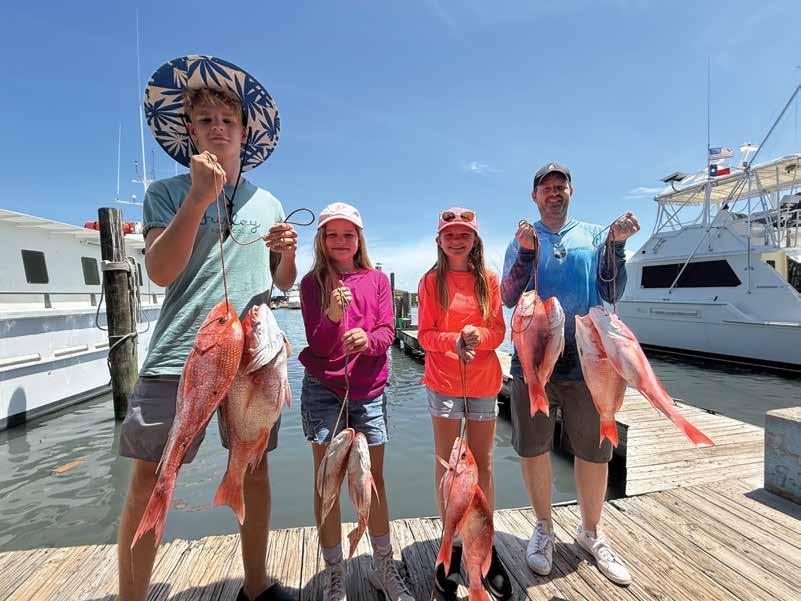
in the cypress roots along the banks, and you need to be able to pull them away from them to keep from breaking off,” Shank said.
On Canyon Lake, he goes up to a 16-pound tippet, especially for striped bass.
“Bass are not tippet shy, and when you’re having to pull them out of grass or structure, 16 pound is nice to have,” Shank said. “I wouldn’t recommend anything less than 3x.”
For Guadalupe bass, he looks for cur-
By Nate Skinner
Ideal weather windows for offshore anglers have been few and far between for most of the early summer. Those able to take advantage of calm conditions have found kingfish to be scattered.
Occasionally anglers have been coming across schools of kings over structure or depth changes in the Gulf. However, most folks who have reported landing king mackerel have only been catching two or three at a time on any given trip.
Capt. Mike Segall, of Reel Threel Charters, said his anglers have only landed two kingfish so far this summer during the few trips when the weather has allowed him to be able to safely venture offshore. Both of the kings were caught about 34 miles out from
“Those two fish were caught on ribbonfish over a hump along the bottom,” Segall said. “The largest of the two was about 25 pounds.”
Segall said other charter captains up and down the coast have said the kingfish have been pretty scarce.
“We just don’t have the amount of rigs out in the Gulf like we used to,” he said. “I think the fish might be more scattered and not as concentrated as they used to be. We used to always catch good numbers of kings offshore, and we just don’t catch that many anymore.”
Port Aransas-area Capt. Danny Dorman said his anglers have been catching one or two kingfish here and there while they have been targeting red snapper.
“We’ve been running out about 40-45 miles out of Port A, and fishing along the edges of rock piles,” Dorman said. “A king-
By Tony Vindell one Star outdoor newS
Anglers fishing for red snapper in federal waters are reeling in bigger fish compared to the early days of the predicted 110-day season.
But just as it began to pick up, Mother Nature has been putting a damper on things with menacing rains and strong winds. Even though the rains have subsided, weather forecasters have been calling for more precipitation.
Though the Fourth of July week did not get the heavy downpours of June 30 and July 1-2, forecasts put a halt to plans for many of the for-hire boat and recreational boat operators.
Only one of three head boats in operation in the South Padre Island-Port Isabel area has been venturing out in federal waters.
That is the Thunderbird, a vessel owned by Capt. Murphy Charter Fishing Services.
The boat, however, stayed on the dock on Monday, June 30 – one of the rainiest days that week.
A few days earlier on June 26, anglers caught decent red snapper compared to the early days of the season when most fish caught barely reached the minimum size of 15 inches.
During the first two weeks, a few anglers reported catching snapper nearly 20 inches long, but no whoppers were brought up. However, bigger fish began to show up delighting anglers from several Texas cities and from as far away as New Mexico and Kansas.
Port Isabel resident Neyri Sosa said her third trip in federal waters went well.
“I caught two snapper plus a bonus,” she said showing her fish stringer. “A strawberry grouper.”
Fernando Pena, from Roma, said he had no complaints.
“I got my two fish,” he said, holding a stringer. “Not too
But for a family of five from Hobbs, New Mexico, the day turned out more memorable.
fish or two have also been striking our skirts or diving baits while trolling while we’ve been targeting wahoo and mahi-mahi.”
Dorman did have one day recently where he came across a school of kingfish that his anglers were able to catch on ribbonfish while drifting over rocks. Those fish were pushing 30 pounds or more, but most of the kings that he’s come across have been smaller.
In the Port O’Connor area, Capt. Josh Estes said he hasn’t heard reports of anyone finding good concentrations of kingfish inside of 30 miles offshore.
“We should start seeing more kings just outside the jetties, out to about 8 miles or so offshore, but it just hasn’t happened yet,” Estes said. “That could also be due to the fact that there just hasn’t been a lot of opportunities for folks to venture out past the jetties so far this summer.”
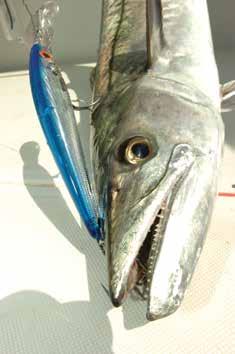

By Vivian Leopold
For Lone Star outdoor newS
Lake Fork Sportsman’s Association joined forces with the Yantis High School Ag class and Texas Parks and Wildlife Department to provide fish attractors for habitat in Lake Fork.
LFSA project chair, Marty Jarrell, secured the materials and served as liaison with Mike Moore’s spring Ag class at Yantis High School that built the 10 fish attractors. Each fish attractor is approximately 3 1/2’ x 7’ with a PVC pipe frame and plastic corrugated drainpipe looped through it.
The design was originally developed by the Georgia Department of Natural Resources. The fish attractors provide cover for fish and serve as a hiding place for young fingerling bass to allow them to hide and grow.
Members of LFSA and a team from TPWD loaded the fish attractors on LFSA’s live-release boat and TPWD’s boat. Weighed down by four cinder blocks, five were sunk on both sides of the County Road 2946 bridge. There are other structures that have been added at Lake Fork, many attributed to previous LFSA projects. The GPS locations can be found on TPWD’s website under Texas Fish Habitat Structures.
Funding in the form of a grant came from Friends of Reservoirs and was matched by LFSA in money and labor. Friends of Reservoirs was established in 2010 as part of the National Fish Habitat Partnership and Reservoir Fisheries Habitat Partnership’s efforts to improve fish habitat conservation from the ground up. Its goal is to promote the protection, restoration, and enhancement of habitat for fish and other aquatic species in reservoir systems.
Lake Fork Sportsman’s Association is an all-volunteer 501(c)(3) nonprofit whose mission is to support Lake Fork as the premier bass fishing lake through preservation and sportsmanship while supporting youth angling programs. It was the recipient of the 2018 Texas Freshwater Fishing Hall of Fame award.
By Craig Nyhus Lone Star outdoor newS
Of 545 available oyster licenses, Texas Parks and Wildlife Department received 115 commercial oyster boat license offers in round nine of its Oyster License Buyback Program, which would represent a 21 percent reduction of total oyster licenses in the state.
TPWD received authority for an oyster license buyback from the Texas Legislature in 2017 and held the first buyback for oyster licenses in 2018. After several years of limited success in purchasing oyster licenses, TPWD changed the approach
with the help of key partners. This round offered a fixed rate for the licenses instead of a reverse bid process used in past buyback rounds.
Although the offers fell short of what the Oyster Buyback Advisory Committee recommended, TWPD said it intends to purchase all 115 licenses, with the help of significant donations from key donors.
In March, the Oyster License Buyback committee approved a plan that was disseminated to all Oyster Harvest License Holders which terminated May 31. The offer was for $30,000 per license and contingent upon a minimum of 150 people accepting this one-time offer.


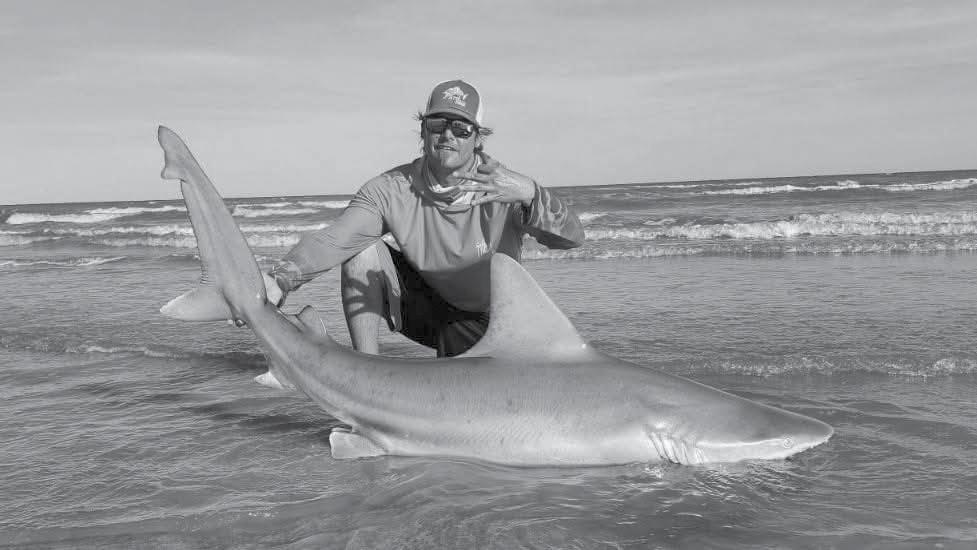
By Cory Byrnes For Lone Star outdoor newS
With all of the recent rains, the typical summer heat has been stayed somewhat, and fishing the surf has been hit-or-miss depending on water clarity. There have been a few surprise species, though, like tripletail and Spanish mackerel caught as the surf clears up.
At Sabine Pass, the surf-fishing has been slow the last three weeks due to off-colored water.
“There has been a lot of gafftop the last couple of weekends,” surf angler John Wal-

ter said.
This past week, the water has cleared up a bit, and fishing conditions have improved. Walter has been targeting shark using live mullet hooked through the tail with a 5/0 circle hook and 2-ounce spider weight.
Most of his success has come around the third gut.
“The third gut is about 75 feet out,” Walter said. “That’s where I have hooked everything.”
In the Galveston area, Jeffery Millet of 3rd Coast Fishin’ said he has been catching some unusual fish.
“We are catching fish we normally don’t




ALAN HENRY: Water clear; 80 degrees; 0.89’ low. Crappie are fair on jigs and minnows.
AMISTAD: Water stained; 82 degrees; 66.60’ low. White bass are good on slabs. Catfish are good on punch bait.
ARLINGTON: Water stained; 85 degrees; 1.39’ high. Largemouth bass are fair on soft plastics and crankbaits.
ARROWHEAD: Water stained; 85 degrees; 0.28’ low. Catfish are good on fresh cut shad.
ATHENS: Water stained; 84 degrees; 0.32’ high. Largemouth bass are good on Texas-rigged worms, wackyrigged senkos and crankbaits. Crappie are slow.
AUSTIN: Water stained; 81 degrees; 0.50’ low. Largemouth bass are fair on swimbaits, drop shots, topwaters and Texas rigs.
BASTROP: Water stained; 90 degrees. Largemouth bass are good on top-waters, swimbaits, jerkbaits and Texas-rigged worms.
BELTON: Water stained; 84 degrees; 0.76’ low. White bass are fair on umbrella rigs and slabs. Catfish are fair on fresh shad and prepared bait.
BENBROOK: Water stained; 83 degrees; full pool. Largemouth bass are good on soft plastics and crankbaits. Crappie are good on minnows. Hybrid striped bass are good on live bait. Catfish are good on cut shad and punch bait.
BOB SANDLIN: Water stained; 87 degrees; 0.04’ high. Largemout bass are good on soft plastics and topwaters. Crappie are good on minnows. White bass are good on slabs and jigs. Catfish are fair on stink bait.
BOIS D’ARC: Water stained; 83 degrees; 0.18’ high. Largemouth bass are good on top-waters, Carolina rigs, Texas rigs, chatter baits and crankbaits. Crappie are good on minnows.
BRAUNIG: Water stained; 88 degrees. Redfish are good on spoons and soft plastics. Catfish are slow.
BROWNWOOD: Water lightly stained; 85 degrees; 0.04’ high. Largemouth bass are slow. Crappie are fair on minnows and jigs. White bass are good on crankbaits. Catfish are fair on cut shad, nightcrawlers and chicken livers.
BUCHANAN: Water lightly stained; 85 degrees; 17.47’ low. Largemouth bass are fair on jigs, swimbaits, top-waters and Texas-rigged soft plastics. White bass and stripers are good on swimbaits, slabs, topwaters and live bait. Catfish are good on cut bait.
CADDO: Water stained; 84 degrees; 1.23’ high. Largemouth bass are good on flukes, frogs, weedless top-waters, swimbaits and Texas rigs.
CALAVERAS: Water stained; 91 degrees. Redfish are good on spoons and soft plastics. Catfish are good on shrimp and stink bait.
CANYON: Water lightly stained; 85 degrees; 19.92’ low. Largemouth bass are good on top-waters and soft plastics. Striped bass and white bass are good on swimbaits and jigging spoons.
CEDAR CREEK: Water lightly stained; 87 degrees; 0.07’ high. Hybrid striped bass and white bass are good on slabs and spinner baits. Crappie are fair on minnows and jigs. Catfish are good on cut bait.
CHOKE CANYON: Water stained; 84 degrees; 35.87’ low. Largemouth bass are fair on soft plastics. Crappie are fair on minnows and jigs. Catfish are good on cut bait.
COLETO CREEK: Water lightly stained, 87 degrees; 0.42’ low. Largemouth bass are fair on soft plastics and crank baits.
CONROE: Water stained; 87 degrees; 0.12’ high. Largemouth bass are good on soft plastics. Crappie are fair on jigs and minnows. Hybrids and white bass are good on minnows, slabs, spoons and crankbaits. Catfish are good on cut bait and stink bait.
COOPER: Water stained; 80 degrees: 0.50’ low. Crappie are good on minnows.
CORPUS CHRISTI: 80 degrees; 13.87’ low. Catfish are fair on cut bait.
EAGLE MOUNTAIN: Water stained; 85 degrees; 0.21’ high. White bass are good on slabs. Crappie are good on jigs and minnows. Catfish are good on prepared bait.
FALCON: Water stained; 89 degrees; 46.28’ low. Largemouth bass are good on crankbaits and Texas-rigged soft plastics. Crappie are slow. Catfish are good on stink bait, shrimp and cut bait.
minnows and jigs. Catfish are fair on prepared bait and cut bait.
FT PHANTOM HILL: Water stained; 80 degrees; 3.09’ low. Largemouth bass are fair on creature baits and soft plastics. Crappie are fair on minnows and jigs.
GRANBURY: Water stained; 83 degrees; 0.12’ low. Largemouth bass are good on soft plastics and lipless crankbaits. Striped bass and white bass are good on slabs and live shad. Crappie are good on minnows and jigs. Catfish are good on cut shad.
GRANGER: Water lightly stained; 80 degrees; 0.39’ high. Largemouth bass are fair on plastic worms. Crappie are good on minnows and jigs. White bass are slow. Catfish are good on shad and cut bait.
GRAPEVINE: Water stained; 85 degrees; 2.60’ high. White bass are good on inline spinners and slabs.
HOUSTON COUNTY:
Water stained; 86 degrees; 0.19’ high. Largemouth bass are fair on Carolina rigs and crankbaits. Crappie are fair on jigs and minnows.
HUBBARD CREEK: Water stained; 80 degrees; 11.64’ low. Largemouth bass are fair on soft plastics. Crappie are good on minnows and jigs.
INKS: Water stained; 80 degrees; 0.90’ low. Largemouth bass are fair on worms, flukes and crankbaits.
JOE POOL: Water stained; 80 degrees; 0.66’ high. Largemouth bass are fair on top-waters and soft plastics. Crappie are good on minnows.
LAKE O’ THE PINES:
Water stained; 83 degrees; 3.88’ high. Largemouth bass are good on crankbaits, Carolina rigs, football jigs and shaky-head worms. Crappie are good on minnows. Catfish are good on punch bait, cut bait and worms.
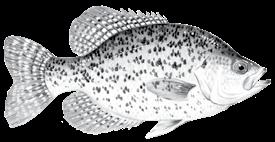
FAYETTE: Water lightly stained; 92 degrees. Largemouth bass are good on crankbaits, shaky heads and Carolina rigs. Catfish are fair on night crawlers.
FORK: Water stained; 82 degrees; 0.10’ high. Largemouth bass are good on top-waters, frogs, crankbaits, and Carolina-rigged soft plastics. Crappie are fair on
LAVON: Water lightly stained; 80 degrees; 0.64’ high.
Largemouth bass are fair on spinner baits, creatures and Texas-rigged worms. White bass are good on top-waters, swimbaits and slabs. Catfish are good on punch bait.
LBJ: Water stained; 85 degrees; 0.21’ low. Largemouth bass are good on jigs and Texas-rigged soft plastics. Crappie are fair on minnows. Catfish are good on punch bait.
LEWISVILLE: Water
stained; 82 degrees; 0.60’ high. White bass are fair on slabs, spoons and live bait. Hybrid stripers are fair on slabs and live bait. Catfish are good on cut shad and punch bait.
LIMESTONE: Water stained; 90 degrees; 0.10’ high. Largemouth bass are good on chatter baits, Texas rigs, Carolina rigs and spinner baits. Crappie are good on minnows. White bass are fair on super slabs. Catfish are good on cut bait and large minnows.
LIVINGSTON: Water stained; 85 degrees; 0.07’ high. White bass are good on slabs. Catfish are fair on prepared bait and shad.
MARTIN CREEK: Water lightly stained; 91 degrees; 0.02’ high. Largemouth bass are fair on Texas-rigged worms and swimbaits. Crappie are good on minnows and jigs. White bass are good on jigging spoons. Catfish are good on punch bait and nightcrawlers.
MEREDITH: Water stained; 81 degrees; 44.67’ low. White bass are good on spoons and soft plastics. Crappie are good on minnows. Walleye are good on minnows and bottom bouncers. Catfish are good on cut bait and frozen shad.
Crappie are fair on minnows and jigs. White bass are fair on minnows. Catfish are good on cheese bait and stink bait.
OAK CREEK: Water lightly stained; 80 degrees; 19.45’ low. Largemouth bass are good on top-waters and crankbaits. Crappie are good on jigs. Catfish are good on cut bait.
PALESTINE: Water stained; 90 degrees; 0.23’ high. Largemouth are good on senkos. Crappie are good on jigs and minnows. White bass and hybrids are good on slabs and crankbaits. Catfish are good on cut bait and stink bait.
POSSUM KINGDOM: Water lightly stained; 87 degrees; 0.27’ high. Stripers are fair on live bait. White bass are fair on slabs. Catfish are good on cut shad and punch bait.
PROCTOR: Water stained; 82 degrees; 0.31’ high. White bass are fair on soft plastics and spinners. Crappie are fair on minnows and jigs.

RAVEN: Water lightly stained; 90 degrees. Largemouth bass are good on soft plastics. Bluegill are good on hotdogs and worms.
nows. Catfish are good on cut shad and punch bait.
SPENCE: Water stained; 80 degrees. 48.34’ low. Largemouth bass are good on soft plastics. Catfish are good on blood punch bait.
STILLHOUSE: Water stained; 85 degrees; 1.76’ low. Largemouth bass are fair on top-waters and soft plastics. White bass are fair on slabs.
TAWAKONI: Water lightly stained; 80 degrees; 0.46’ high. Largemouth bass are good on crankbaits, flukes and frogs. Hybrid stripers and white bass are good on slabs, swimbaits,and live bait. Crappie are good on jigs and minnows. Catfish are good on punch bait and dip baits.
TEXANA: Water stained; 80 degrees; 0.05’ low. Catfish are good on trotlines.
MILLERS CREEK: Water stained; 78 degrees; 0.93’ low. Largemouth bass are slow. Crappie are fair on minnows and jigs. White bass are fair on slabs and soft plastics. Catfish are slow.
NACOGDOCHES: Water stained; 88 degrees; 0.21’ high. Largemouth bass are fair on soft plastics and crankbaits. Crappie are good on minnows and jigs.
NACONICHE: Water lightly stained; 88 degrees; 0.50’ high. Largemouth bass are fair on jerkbaits, soft plastics and crankbaits. Crappie are good on minnows. Catfish are slow.
NASWORTHY: Water lightly stained; 79 degrees. 0.96’ low. Largemouth bass are good on soft plastics. Crappie are fair on jigs. Catfish are fair on cut bait and stink bait.
NAVARRO MILLS: Water stained; 75 degrees; 1.57’ high. Largemouth bass are good on soft plastics. White bass are slow. Crappie are fair on jigs and minnows. Catfish are good on shad and perch.
O H IVIE: Water lightly stained; 81 degrees; 23.40’ low. Largemouth bass are fair on jigs, top-waters and frogs.
RAY HUBBARD: Water stained; 83 degrees; 0.10’ low. White bass are good on swimbaits, tail spinners and lipless crankbaits. Crappie are fair on minnows and jigs. Catfish are good on punch bait.
RAY ROBERTS: Water lightly stained; 84 degrees; 0.32’ high. Largemouth bass are fair on plastic worms, crankbaits,and football jigs. Crappie are slow. White bass are fair on slabs. Catfish are good on cut bait.
RICHLAND CHAMBERS: Water stained; 83 degrees; 0.13’ high. Largemouth bass are fair on top-waters, crankbaits, jigs and soft plastics. White bass are slow. Crappie are slow. Hybrid stripers are good on live shad. Catfish are fair on cut bait and shad.
SAM RAYBURN: Water stained; 86 degrees; 0.49’ high. Largmeouth bass are fair on soft plastics, crankbaits and Carolina rigs. Crappie are good on minnows. White bass are fair on slabs. Catfish are good on cut bait.
SOMERVILLE: Water stained; 84 degrees; 0.93’ high. Largemouth bass are fair on crankbaits and spinner baits. White bass are good on spoons. Hybrids are good on cut bait and mussels. Crappie are good on jigs and min-
TEXOMA: Water stained; 84 degrees; 2.44’ high. Largemouth bass are fair on crankbaits, moving baits and soft plastics. Stripers are fair on live bait, top-waters and swimbaits. Catfish are good on punch bait and cut bait.
TOLEDO BEND: Water stained; 85 degrees; 0.66’ low. Largemouth bass are good on frogs, top-waters, swim jigs, crankbaits and Carolina rigs. Crappie are fair on minnows.
TRAVIS: Water stained; 87 degrees; 23.01’ low. Largemouth bass are good on worms, craws and swimbaits.
WACO: Water stained; 84 degrees; 0.45’ high. Largemouth bass are slow. Crappie are fair on minnows.
WALTER E LONG: Water stained; 87 degrees. Largemouth bass are good on lipless crankbaits, spinner baits, jerkbaits and A-rigs.
WHITNEY: Water lightly stained; 82 degrees; 0.29’ high. Largemouth bass are good on soft plastics. Striped bass are fair on live bait. Crappie are fair on jigs and minnows. White bass are good on slabs. Catfish are fair on cut bait.
WORTH: Water stained; 85 degrees; 0.06’ high. Catfish are fair on punch bait.
WRIGHT PATMAN: Water stained; 85 degrees; 9.28’ high. Crappie are good on minnows and jigs. Catfish are fair on punch bait.

Continued from page 1
holding in specific areas, day in and day out, so he has been able to consistently stay on them.
Most of the fish have been anywhere from 1824 inches in length.
“The schools have been fairly cooperative and have been relatively easy to stay within casting distance once we locate them,” Sinclair said. “Chasing these schools has been produc ing a bunch of multiple hook-ups with our an glers. It’s really been a lot of fun.”
Corpus Christi Capt. Tim Meyer said the black drum bite has been on fire.
“The best schooling action for drum has been taking place after the sun gets higher in the sky during the late morning hours,” Meyer said. “It’s a lot easier to see the fish after the sun comes up, and that makes it easier for folks to make accurate casts to them.”
Most of the schools have been holding in 3-4 feet of water over flats with grass beds and sandy potholes.
“The fish are eating small crustaceans and crabs that are hiding in the grass between the sand pockets,” Meyer said. “We have been catching them on fresh dead shrimp rigged on jig heads.”
Meyer varies the size of the jig head depend ing on the wind and whether the fish are holding tight to the bottom or along the top half of the water column. Most of the black drum have been from 16-22 inches.

Capt. Jesse Torres has been chasing schools of black drum in Baffin Bay in about 1.5-2 feet of water along the edges of grass beds where the seagrass transitions to a sandy bottom.
“The fish are grubbing along the bottom and feeding near the edges of the grass,” Torres said. “Because these schools are pretty shallow, you have to be mindful how you approach them, otherwise they will spook off to deeper water in a hurry. They can be pretty hard to target if you can’t see them.”
Torres said mid-morning has been the best time to catch them.
“As the sun rises and the water heats up, the fish start to pile up along the edges of the grass,” he said.
Torres has been breaking the head off fresh dead shrimp and then threading the shrimp onto a bare hook or the hook of a light jig head.
“The best approach has been to cast the bait past the school or ahead of them in the direction they are moving, and then bring the bait back to them, right in front of their noses,” he said. “If you cast right in the middle of the school, you’re more than likely going to spook them.”
Continued from page 8

rent.
“The Guadalupe bass will hang in a riffle or right on the edge of a riffle,” Shank said. “Guadalupe bass will hang out in a little more current than largemouth. They are an aggressive feeder and great for first-time anglers. They will take streamers, poppers, nymphs like the Head Stand readily; but typically, for better-sized Guadalupe bass, I like to use a baitfish streamer or crawfish streamer.”
Other favorite productive flies are sparkle minnows, kreelex, deer hair frogs, witlocks, nearnuff craw, and buggle bug poppers.
Largemouth bass prefer slower-moving water, larger pools, and structure.
“Target the banks with cypress roots or laydowns or where the bank overhangs,” Shank said. “On the lakes, you’re primarily going to focus your efforts around grass, hydrilla, and lily pads.”
The bass have been schooling on the lake, he said, which indicates time to use a baitfish pattern.
“This works for numbers of bass and panfish as well,” Shank said. “With new fly anglers, it can be 50 fish days with small bass and sunfish with a white popper and assorted nymphs behind it (called a popper dropper.)”
For lakes with a lot of lily pads, Shank recommended more frog patterns.
“The important thing is to match the hatch,” he said.


After devastating floods caused by the remnants of Tropical Storm Barry, Texas game wardens and many other law enforcement departments changed their focus over the July 4 holiday weekend. Ten inches of rain or more fell within a few hours in some areas, most dramatically causing flooding along the Guadalupe River, which rose 26 feet in 45 minutes. The flow over hilly and rocky terrain resulted in catastrophic flash floods, reminiscent of the floods of 1987 along the Guadalupe, and which some officials say was even worse than the historic flood. The rains and moving water happening overnight compounded the tragedy, as many people camping along the river were asleep.
More than 150 game wardens, 158 off-road equipped vehicles, 37 boats, 10 search and rescue teams, two helicopters, rescue swimmers and 16 unmanned aerial system operators responded and conducted search and rescue efforts within hours. Wardens rescued 302 people, including air lifts and children from Camp Mystic.
The loss of life was significant. As of July 8, in Kerr County alone, there were 87 people confirmed dead, including 28 children, and there remained 10 campers and one camp counselor unaccounted for.
Camp Mystic, a popular summer camp for daughters of Texans and families from other states for nearly a century, lost several campers and also its director, Dick Eastland, who died while attempting to evacuate campers.
At nearby Camp La Junta, Eagle Scouts saved many young boys by swimming and lifting them onto the rafters of a building minutes before the walls broke away. The structure held and the boys survived.
Flooding also impacted areas along the San Saba, Llano and San Gabriel rivers. There were three deaths in Burnet County, one in Williamson County, four in Travis County and two in Kendall County attributed to the flooding, with as many as 21 people still unaccounted for.
The Coast Guard also responded with helicopter aircrews, rescuing 15 campers and people from a mobile home community in Leander.




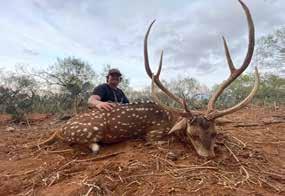









n
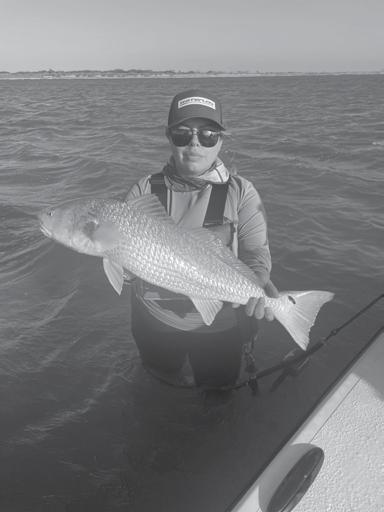
















The Ruger American ® Rifle Generation II is an update to the American-made rifle that has been the benchmark for accuracy, durability, and performance in bolt-action rifles for over a decade. Designed with customer feedback in mind, the Ruger American Rifle Generation II is available in a variety of calibers and is sure to become the first choice for hunters and firearms enthusiasts.

LEARN MORE

15
20 Sun 1:45 8:00 2:15 8:30 06:33 08:20 2:07a 4:49p
21 Mon 2:39 8:54 3:10 9:25
24



Continued from page 1
range,” he said. “You just have to be willing to move around until you find them and are able to get them to bite. For whatever reason, some of the better fish have been feeding later in the day rather than during the early morning hours.”
Live minnows have been producing more bites than jigs, mostly because of the wind.
“You really have to keep the jig still, right in front of their face, in order to get them to bite,” he said. “It’s difficult to hold a jig still right in front of them during windy conditions, so minnows have been producing more strikes.”
Koberna has also been spending a lot of his time on Bois d’Arc Lake, where he said the action has been more consistent.
“Shallow brush piles in 20 feet of water or less are loaded with crappie on Bois d’Arc,” he said. “I’ve been focusing on stretches along the edges of creek channels and flats in 12 to 24 feet, where we’ve been able to catch two or three fish at a time, off of every little piece of timber, tree branch or isolated tree.”
Koberna has been covering water on Bois d’Arc until he finds crappie.
“They haven’t been in the same place every day, but there’s plenty of them out there that are willing to eat,” he said.
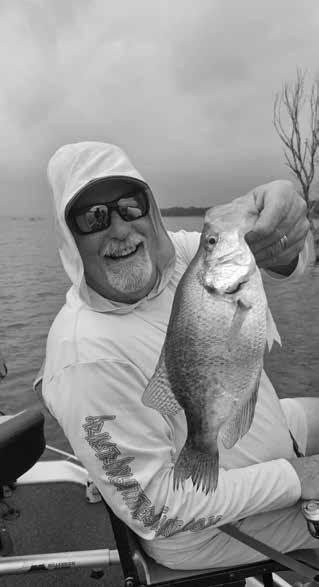
On Lake Fork, guide Russell Rollins said large white crappie are concentrating along the main river channel in 8-22 feet.
“There’s also plenty of fish over brush piles, but most of them are pretty small,” Rollins said. “Swarms of shad are moving along the river channel, and that’s why the larger crappie are staging there. The fish are sitting along underwater timber and ambushing the shad as they swim by, so you have to be able to swim your jig or minnow right past them to get them to bite.”
Most of the crappie that he and his anglers have been catching have been in the 12-17inch range.
“You’ve got to cover water along the river channel to find them, but you can catch some really nice crappie right now on Fork,” Rollins said.
On Lake Conroe, Mike Cason said the crappie bite has been sporadic over brush piles in 13-23 feet of water.
“Some days are really good, and some days are just alright,” he said. “Hair jigs are producing more strikes than soft plastic jigs, and minnows are catching the most fish.”
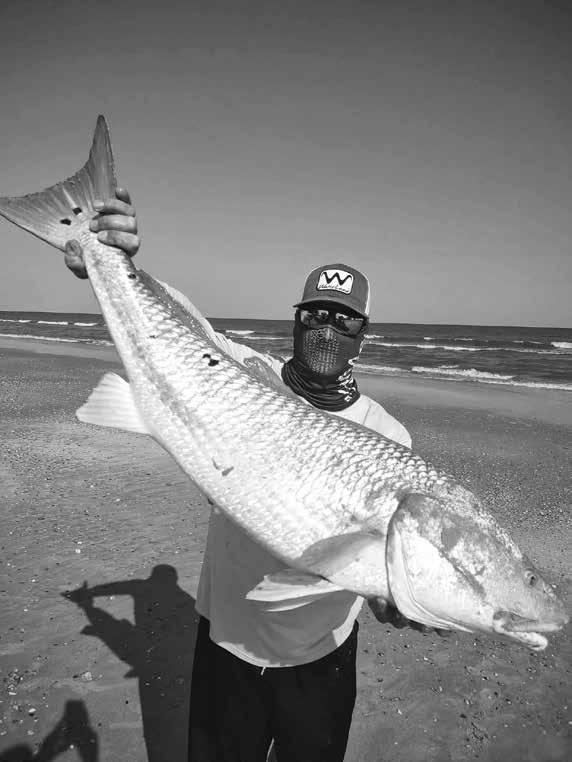
Spanish mackerel,” Millet said.
Millet usually targets sharks, but sometimes seeks the smaller fish.
“For the smaller fish, I use Fishbites, live shrimp and cut mullet,” he said. “It seems to work pretty well for most stuff.”
He recommends using spoons for ladyfish and other cruising fish he sees while walking the beach. He uses a 9-foot rod with 30-pound test.
For shark, he drones his bait out about 500 meters.
“Cownose ray is a key bait these days,” Millet said. “Really, anything that’s in the surf is good bait to use for them.”
He said the fish will move farther out later in the summer.
“It makes fishing a little tougher, but keeping around structure and moving water helps,” he said.
On Padre Island, Tristian Sabrsula has been having success targeting sharks and
bull reds from the beach with cownose rays for sharks and finger mullet for reds.
“The water was absolutely beautiful, and that new moon starting had all the offshore water pushed in,” he said. “I couldn’t ask for the water to be any cleaner in Texas.”
He walks out to the first sandbar and casts in between the second and third gut.
“If the current and surf aren’t bad, I’ll walk out to the second sand bar and cast as far as I can,” he said.
For bigger sharks, he uses a drone to get his baits out.
“If you get a hit and don’t hook up, wait about 10 minutes in case that fish comes back, and if not, reel it in to make sure you have bait,” he said.
The anglers said perfect conditions include a north-to-south wind when it’s laying the waves down in the surf. The sharks prefer the cleaner, clearer water when the surf isn’t too rough, but dirty water doesn’t seem to bother the reds.




Solution on Page 26

ACROSS
1) Fishing wader brand
10) Trout species
11) A creature bait
12) Minnow species
15) Temple’s county
16) New Braunfels’ county
17) Left side of the boat
18) Fort Stockton’s county
19) Longview’s county
20) Border lake
21) Colorado River town
23) Salmon species
25) One of the pointers
27) Exotic in Texas
32) Sounds of the tom
35) Central Texas lake
36) Duck hunters’ group, ___ Waterfowl
39) Rains County’s seat
40) Kerrville’s county
41) An African antelope
43) Centerville’s county
44) Big game hunters’ org.
45) Bass hiding spots
46) Abilene-area lake
DOWN
2) Popular top-water lure 3) Kingsville’s county
Fishing knot type 5) One of the labs 6) A deer favorite 7) A duck favorite 8) Bowhunting TV host 9) Duck call brand
13) One of the cats 14) Lake by New Braunfels
15) San Antonio-area lake
16) Coastal bay
18) One of the fins
20) Jig type
21) Trap type
22) Bosque River town
24) Turkish rifle, shotgun brand
26) Edinburg’s county
28) All-time bass fishing money winner
29) Brewster County’s seat
30) Medina County’s seat
31) Sinker type
33) Italian shotgun brand
34) Rifle brand
37) A dabbler
38) Hill Country lake
42) The female bighorn

Performance Engineering acquired
Wilson Combat’s sister company, Lehigh Defense LLC, acquired all assets of Performance Engineering.
New Silencer Central exec
Silencer Central hired industry veteran Kelly Streiff as its chief revenue officer.
New CEO at Katadyn Group
Karl A. Baumann was appointed chief executive officer of Katadyn Group.
Hines promoted at FN America
FN America promoted Dan Hines to vice president, commercial products.
New DSC chapter
Dallas Safari Club announced the formation of the DSC Safari Anyone Chapter, based in Eastern Tennessee.
Davis joins NSSF
Lisa Davis joined the National Shooting Sports Foundation as vice president, human resources.
Ruger buys Anderson Manufacturing
Sturm, Ruger & Company, Inc. announced the asset purchase of Anderson Manufacturing, a manufacturer of firearms and firearm accessories based in Hebron, Kentucky.
New COO at Kimber
Kimber Mfg. announced the promotion of Scott Moore to chief operations officer.
Marketing head sought at CSF
The Congressional Sportsmen’s Foundation is seeking a new head of marketing and communications.
*email LSON your favorite recipe to editor@lonestaroutdoornews.com.
1 quart filleted and skinned bluegill (bass or other panfish will work), cut into 1-inch squares.
3 pint-sized canning jars
Brine:
2 cups vinegar
2 cups warm water
1 cup kosher salt
Pickling liquid:
2 cups vinegar
1 1/2 cup water
3/4 cups sugar
2 tbsps. pickling spice
1 quart brined fish fillets
1/2 cup sweet white wine
1/2 sweet yellow onion, thinly sliced
1/2 red bell pepper, thinly sliced
1/2 carrot, peeled and thinly sliced into rounds
Place fish in freezer bag and freeze 48 hours to kill parasites. Dissolve salt in water and vinegar and once chilled, submerge thawed fillets into liquid. Cover and put in the refrigerator for 5 days, stirring once daily. After 5 days, the flesh should be firm to the touch and white in color. Rinse fish in cold water twice and then soak in cold water for about 30 minutes. Return fish to the refrigerator and prepare the pickling liquid.
In a pot combine the vinegar, water, sugar, pickling spice, and wine. Warm until the sugar dissolves and allow the liquid to chill again. In the canning jars, layer fish, onion, pepper, carrot and fish until the jars are full. Pour pickling liquid over fish and vegetables. Attach lids and put them in the refrigerator for a week. Store the final product in your refrigerator and enjoy within 6 weeks.
—Ohio DNR

2 bell peppers
2 large onions
1 jar mole
4 serrano peppers
1 50- to 80-lb. feral hog Salt
Fajita seasoning
Chili powder
Vegetable oil
Dice hog meat into ½-inch sizes. Using a large 5 gallon pot, pour 1 cup of vegetable oil in the pot. Dice up the bell peppers and onions. Fire up the pot. When the oil gets hot, place the diced bell peppers, serrano peppers and onions in the pot and lightly brown. Place the diced feral hog in the pot and add about 1 quart of water. With a large spoon, stir and cook for about 1 hour. Add salt, fajita seasoning and chili powder to taste. Add the jar of mole and continue to stir to keep the meat from sticking. Add water as needed to have a gravy texture. Cook for an additional 2 hours until meat is tender. Serve with flour tortillas and pico de gallo.
—TPWD
SABINE LAKE: 82 degrees. Speckled trout are good on live shrimp under a popping cork. Redfish are good on soft plastics and live shrimp. Black drum are fair on Carolina rigged live shrimp.
BOLIVAR: 83 degrees. Redfish and black drum are good on live shrimp. Speckled trout and sand trout are fair on live shrimp.
TRINITY BAY: 80 degrees. Redfish and speckled trout are fair on soft plastics and live shrimp. Flounder are fair on live shrimp and live finger mullet.
EAST GALVESTON BAY: 87 degrees. Speckled trout and redfish are good on live shrimp, croaker and soft plastics.
GALVESTON BAY: 87 degrees. Speckled trout and redfish are good on live shrimp, croaker and soft plastics. Black drum are good on live shrimp.
WEST GALVESTON BAY: 87 degrees. Speckled trout and redfish are good on croaker, live shrimp and soft plastics.
TEXAS CITY: 80 degrees. Speckled trout and redfish are fair on live shrimp and finger mullet.

FREEPORT: 82 degrees. Speckled trout, redfish and black drum are good on live shrimp under a popping cork.
EAST MATAGORDA BAY: 82 degrees. Speckled trout and redfish are fair on live shrimp, croaker, soft plastics and topwaters.
WEST MATAGORDA BAY: 82 degrees. Speckled trout and redfish are fair on live shrimp, croaker and soft plastics.

PORT O’CONNOR: 82 degrees. Speckled trout are fair on live croaker. Redfish are fair on Spanish sardines. Black drum are fair on shrimp.
SAN ANTONIO BAY: 83 degrees. Speckled trout and redfish are good on top-waters and live shrimp.

ROCKPORT: 80 degrees. Speckled trout are good on live shrimp, piggy perch and croaker. Redfish are fair on shrimp, mullet, pin perch and menhaden. Black drum are fair on live and dead shrimp.
REDFISH BAY: 80 degrees. Redfish are fair on cut mullet. Black drum are good on dead shrimp.
PORT ARANSAS: 80 degrees. Redfish are good on live shrimp, finger mullet and shad. Oversized redfish are good on cut crab and mullet. Speckled trout are good on croaker and shrimp.
CORPUS CHRISTI: 80 degrees. Redfish are fair on cut mullet. Black drum are good on dead shrimp.
BAFFIN BAY: 83 degrees. Speckled trout and redfish are good on soft plastics and top-waters.
PORT MANSFIELD: 78 degrees. Speckled trout and redfish are good on soft plastics and top-waters.
SOUTH PADRE: 85 degrees. Speckled trout are good on live shrimp under popping corks. King mackerel and Spanish mackerel are good trolling and on live bait. Red snapper are good on sardines and cigar minnows. Mangrove snapper are good on live shrimp.
—TPWD
Avid upper coast offshore angler, Rick Wilkenfeld, said he has not caught any kingfish while running offshore out of Texas City inside of 50 miles during the summer months
“We haven’t even seen one randomly jump or bust some bait on the surface while snapper fishing this summer,” he said. “There just doesn’t seem to be the numbers of

Adrian Creasey said he had one calm day recently where he was able to catch some kingfish while drift-fishing with ribbonfish out off the ends of the Port Aransas jetties.
“The tide was incoming and the water was clean,” he said. “It was like a small school came through. I had three rods out, and I was able to catch a few before the bite completely stopped.”










The National Marine Manufacturers 2024 report showed that total outboard sales fell 7.6 percent in 2024 to 278,000 units.
According to the report, pricing remained stable, and demand for higher horsepower engines was strong. Engines at 300 horsepower and above led the market with over 40,000 new units sold, nearly 35 percent of the total market.
The South Atlantic, Great Lakes and Gulf Coast markets accounted for more than 63 percent of total unit sales and 66 percent of total market value.
The total retail value of sales nationwide was $3.6 billion.
—NMMA
The U.S. Coast Guard released its 2024 Recreational Boating Statistics Report, which showed the fewest boating fatalities since the Service began collecting statistics more than 50 years ago.
Fatalities fell 1.4 percent to 556 from 564 in 2023, while overall incidents increased by 1.1 percent from 3,844 to 3.887. Nonfatal injuries increased 2.1 percent from 2,126 to 2,170.
The fatality rate was 4.8 deaths per 100,000 registered recreational vessels, a 2 percent decrease from last year’s rate of 4.9 deaths per 100,000. In 1971, when the Safe Boating Act was first passed, the rate was 20.6 deaths per 100,000. Property damage totaled $88 million, and operator inattention, improper lookout, operator inexperience, machinery failure and navigation rules ranked as the top five primary contributing factors in accidents.
There was an increase in deaths on standup paddleboards.
—USCG
The Pennsylvania legislature cleared the way for additional Sunday hunting, one of the last remnants of the state’s “blue laws.”
The state has had Sunday hunting for fox, coyotes and crows, but the new bill, HB 1431, will allow the Pennsylvania Game Commission to implement additional Sunday hunting opportunities for other species.
—Staff report
The Cabela Family Foundation announced a major milestone for their 24 Lions initiative. In 2018, the foundation took on the largest wild African lion translocation in history, moving 24 lions from South Africa into Coutada 11 of Mozambique.
There was not a viable population of lions in this area due to years of ongoing civil war, poaching, and the area being difficult for lions to access to recolonize. In fact, lions were considered “functionally extirpated” as of 2017. All of the funding for the project was raised by the Cabela Family Foundation and a sustainable hunting and conservation model led by Zambezi Delta Safaris.
Seven years later, the initiative is has reached a population surpassing 100 lions.
Hunting in Angola was thought to be lost forever after a long and brutal civil war. Now, by Presidential Decree, Angola will reopen tourist hunting this fall.


Safari Club International announced the appointment of Seth D. Feldman, EdD, JD as its new General Counsel. Feldman brings a wealth of experience at the intersection of law, education, and nonprofit leadership.
—SCI
Conservation Force assisted with language for national regulations, the establishment of the Angola Hunters Association, the establishment of quotas and training courses on trophy skinning and preparation.
The official opening is August 1 in Carivo, near the city of Benguela in the south of the country. Conservation Force and Dallas Safari Club will be in attendance. The first hunt will be auctioned during the DSC Foundation’s Gala Dinner and Auction during DSC’s Summer Expo. The Ministries and newly formed Angola Hunters Association will be there in person.
Continued from page 1
stamp required for suppressors from $200 to $0.
The National Firearm Act process and registry remains, including the forms, fingerprints and required approvals.
The American Suppressor Association said the reduction would reduce taxes on gun owners by $200 milion annually.
The ASA, along with the National Rifle Association, Firearms Policy Coalition and Second Amendment Foundation said they planned to challenge the NFA following the elimination of the tax.
The removal of the excise tax will begin Jan. 1, 2026.

office delivery, go to LSONews.com, or call (214) 361-2276, or send a check or money order to the address below. Lone Star Outdoor News, ISSN 2162-8300, a publication of Lone Star Outdoor News, LLC, publishes twice a month. A








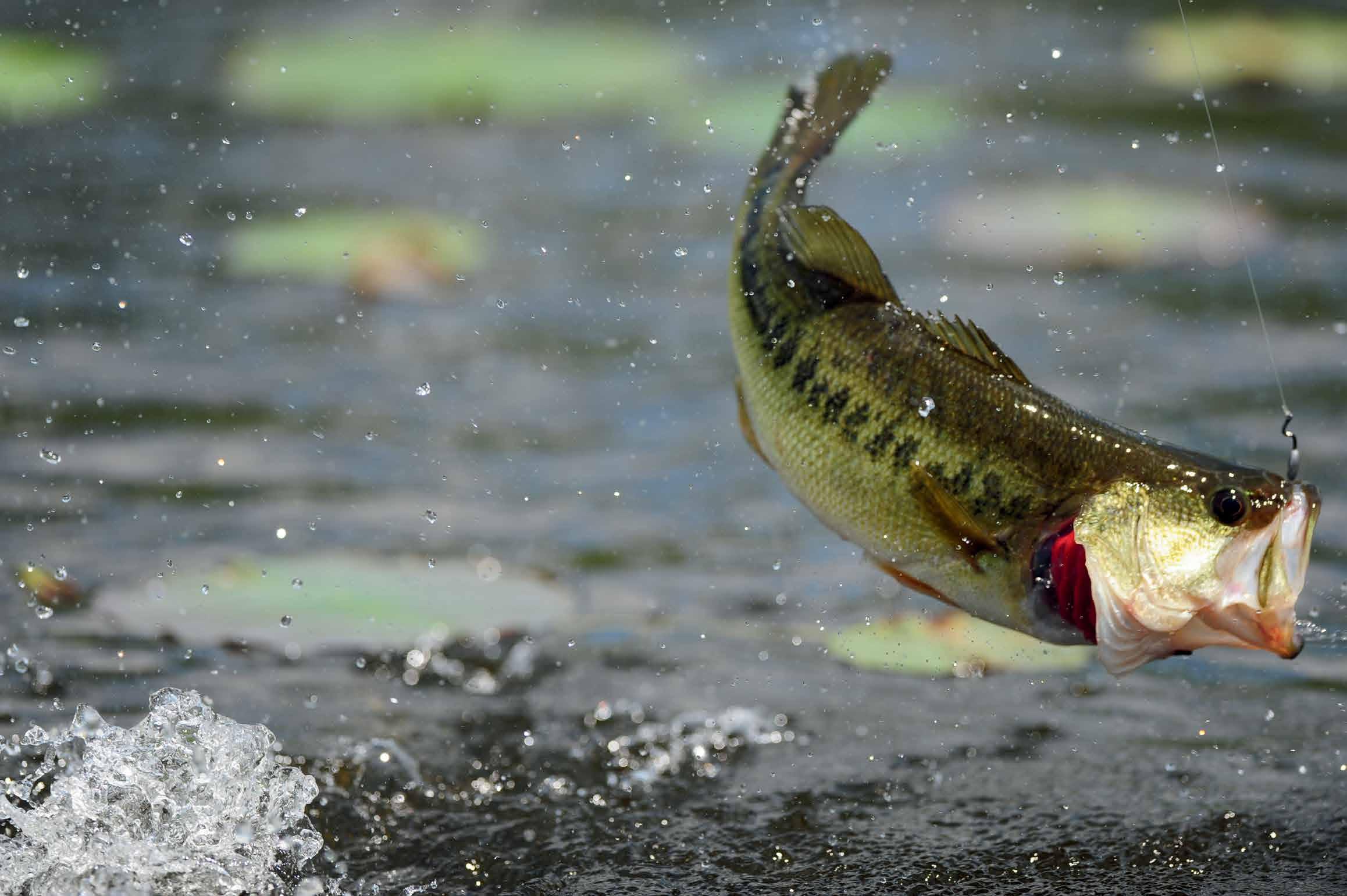






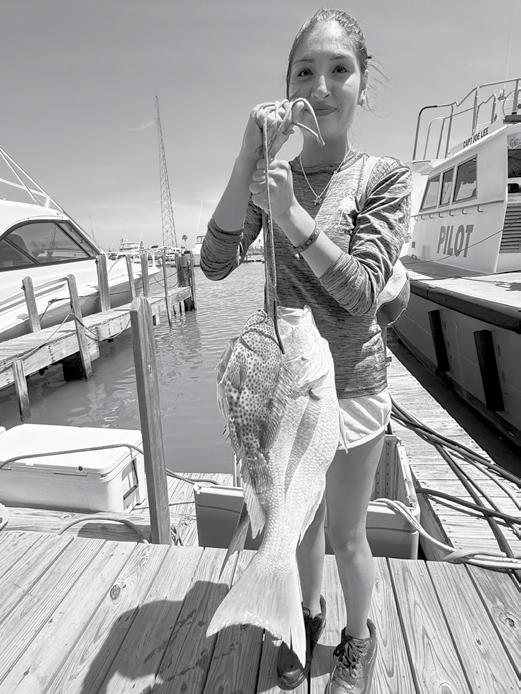
Bart Gatewood said this was their first red snapper trip even though they have been coming to the island for a number of years.
“We went bay fishing last year,” he said. “We caught quite a few trout.”
This time they opted to go out in federal waters and returned with two fish each. The only downside was two of them got seasick, but rode the waves like everyone on the boat.
Carlos Perez, a dentist from Matamoros, Mexico, caught a couple of good-sized red snapper.
He credited his success to the mullet he

caught from his cabin deck in Arroyo City the morning before he rode to the island to board the boat.
“It worked out pretty good,” he said, showing his catch of the day. “I am going to have them cooked zarandeados.”
He was referring to a south-of-the-border cooking method in which fish is prepared with mayonnaise, soy or Worchester sauce, guajillo chiles, garlic, salt, pepper and other spices. The fish is split in half from head to tail and placed on foil over hot charcoal or cooked in a skillet.
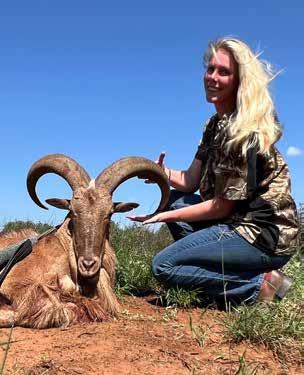



JULY 11-13
GOD & THE GREAT OUTDOORS EXPO
The Oil Palace, Tyler godandthegreatoutdoors.com
JULY 12
MULE DEER FOUNDATION
Llano County Banquet
Inman’s BBQ, Llano (432) 290-4563 muledeer.org
JULY 17-19
DALLAS SAFARI CLUB
Summer Expo & Foundation Gala

Gaylord Texan Resort, Grapevine (972) 980-9800 biggame.org
JULY 18-20
TEXAS HUNTERS & SPORTSMAN’S EXPO
McAllen Convention Center (956) 789-1456
texashunterassociation.com
JULY 19-20
TEXAS GUN & KNIFE SHOWS
Amarillo Civic Center (830) 285-0575 texasgunandknifeshows.com
JULY 26
ROCKY MOUNTAIN ELK FOUNDATION
Gulf Coast Banquet
Knights of Columbus Hall, Pearland (281) 245-9723 rmef.org

MULE DEER FOUNDATION
Culberson County Banquet
The Nido, Van Horn (432) 290-4563 muledeer.org

(817) 999-1395
SITKA IN DALLAS

is looking for part time and full-time sales and marketing positions. Call (469) 445-1123
4,900-ACRE STONEWALL COUNTY HUNTING LEASE: Trophy whitetail deer, dove, hogs. On historic JD Patterson Ranch in northwest TX with 20+ years in TPWD management program. Also MLD participant. $12 per acre. Low fence. One-year provisional lease. Option to extend based on responsible stewardship of native wildlife/habitats.
JULY 31
ROCKY MOUNTAIN ELK FOUNDATION
Central Texas Banquet
The Exchange Event Center
McGregor (254) 707-0081 rmef.org
AUGUST 2
ROCKY MOUNTAIN ELK FOUNDATION
North Texas Banquet
Embassy Suites, Grapevine (214) 693-8523 rmef.org
SAFARI CLUB INTERNATIONAL
Lubbock Chapter Banquet Lubbock Memorial Civic Center lubbocksci.org
AUGUST 1-3
TEXAS TROPHY HUNTERS ASSOCIATION
Houston Extravaganza
NRG Center (210) 523-8500 ttha.com
AUGUST 7
EXOTIC WILDLIFE ASSOCIATION
Conservation Extravaganza Hyatt Regency Hill Country San Antonio myewa.org
AUGUST 8-10
TEXAS TROPHY HUNTERS ASSOCIATION Fort Worth Extravaganza Fort Worth Convention Center (210) 523-8500 ttha.com
TEXAS GUN SHOWS
Legends Event Center Bryan (210) 844-9599 gunshowstx.com

Continued from page 9
Chuck Nasier, the president of Flatsworthy and a member of the Oyster License Buyback Committee, said despite the committee’s recommendation, TPWD, along with the Coastal Conservation Association, decided to go ahead with the purchase.
“I’m on the fence about that,” he said. “We would have wobbled 10 percent or so, but this is a 20 percent wobble. But the logic is that these are licenses that will never go back to damaging the resource. However, most of these licenses were the least active in the fleet.”
Nasier said efforts to protect public oyster reefs will continue.
“We’re going to keep working,” he said. “The mission of TPWD is to protect the resource, period.”
Nasier said the reefs need protection vertically, or at the tops of the reefs.
“That protects the reef from floods, et cetera,” he said.
“It’s out of sight, out of mind,” he said. “If it was in a forest, people would be up in arms.
“An update on Apple Maps shows the dredge marks where the bottom is torn up. It’s a clear example of strip mining and the damage it is doing.”
Earlier this year, the department joined forces with Texas Parks and Wildlife Foundation to create a public-private partnership and establish the S. Reed Morian Oyster Buyback Program to raise the funds needed for this latest round of buybacks. A volunteer-led group of conservation-minded individuals and foundations has pledged their support.



Puzzle solution from Page 20
RENO EQUIPMENT/ RIO GRANDE PIPE
Our companies sell structural pipe in several sizes, from small pipe for gates, to standard sizes for fencing, on up to the larger sizes for H-braces, barn legs and even culverts. We stock pipe sizes from 1” to 20”, we even have heavy weight and thick wall pipe in several sizes for heavy duty projects. We also sell an assortment of other equipment, currently we have some surplus tanks (8400gal, steel, 12’w x 7’h), some tinhorn/culvert material (from 4’dia x 6’-10’L to 16’dia x 10’-20’L), 18’ & 20’ gooseneck tandem single trailers, and some cattle guards. Contact Josh Brown at (505) 366-3428, or Cody Hudson at (575) 441-1186.
AUSTRALIAN WATER BUFFALO HUNTS Come see us at the DSC Summer Expo July 17-19 Grapevine, Texas Graham Williams BUFFALO577.COM BUFFALO577@HOTMAIL.COM
HUNTING EXOTICS, WHITETAIL. BEST PRICES. NO MIDDLEMAN. LETS HAVE FUN. (830) 928-0370
LAND & RANCH FOR SALE
Thomas A.C. Davis Tyler, TX TDAVIS@TEXASRANCHSALES. COM
ARCHERY CLUB Network of Archery Ranges For One Membership! TEXASARCHERY.INFO
CALLING ALL DUCK HUNTERS!
Prime 17-acre property on Lake Bois D Arc Perfect for your dream hunting cabin. Over 1,240
AFRICA Hunting: All Inclusive - No surprises Includes: Animals, daily rates, taxidermy, shipping home. To find out more: LONESTARAFRICA.COM
PROFESSIONAL BOOKKEEPING SERVICES From a name, you know and trust Contact Lea Marsh Accounts payable/receivable/payroll Small business, nonprofit or


